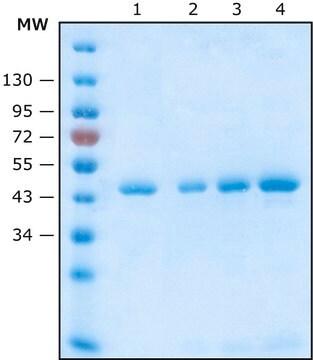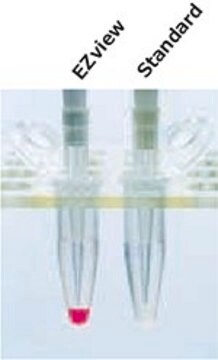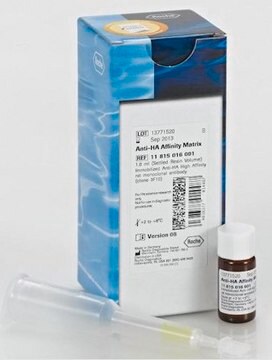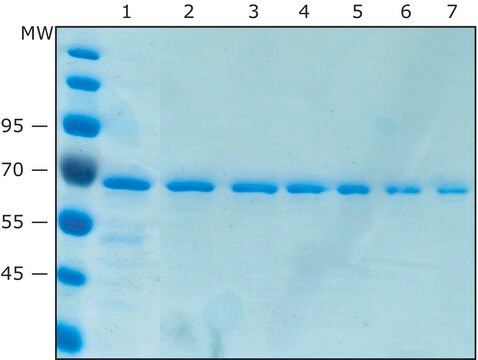Recommended Products
antibody product type
primary antibodies
Quality Level
clone
monoclonal
analyte chemical class(es)
proteins (hemagglutinin)
technique(s)
immunoprecipitation (IP): suitable
storage temp.
2-8°C
Related Categories
General description
Anti-hemagglutinin (HA) Immunoprecipitation Kit is designed to recover maximum amounts of HA-tagged proteins in the immunoprecipitates. The process is carried out in mini-spin columns instead of microcentrifuge tubes to ensure easy washing of antigen-antibody-bound beads with minimal variability.
Application
Anti- hemagglutinin (HA) Immunoprecipitation Kit has been used for immunoprecipitation. It has also been used in in vitro acetylation assay from human embryonic kidney cell lines.
Features and Benefits
- Anti- hemagglutinin (HA) coupled beads enable high specific binding to HA-tagged fusion proteins
- Coupling of Anti-HA antibodies to the beads eliminates other preliminary and calibration steps
- Mini-spin columns enable the minimal loss of anti-HA-bound beads during washing
- The CelLyticTM M cell lysis reagent provides a high yield, rapid and efficient mammalian cell lysis
- Ready-to-use cell lysis reagent and 10X concentrated immunoprecipitation buffer
Not finding the right product?
Try our Product Selector Tool.
Storage Class Code
10 - Combustible liquids
WGK
WGK 3
Flash Point(F)
Not applicable
Flash Point(C)
Not applicable
Certificates of Analysis (COA)
Search for Certificates of Analysis (COA) by entering the products Lot/Batch Number. Lot and Batch Numbers can be found on a product’s label following the words ‘Lot’ or ‘Batch’.
Already Own This Product?
Find documentation for the products that you have recently purchased in the Document Library.
Customers Also Viewed
Podocyte-Specific Overexpression of Wild Type or Mutant Trpc6 in Mice Is Sufficient to Cause Glomerular Disease
Krall,P et al.
PLoS ONE, 5(9) (2010)
Paola Krall et al.
PloS one, 5(9), e12859-e12859 (2010-09-30)
Mutations in the TRPC6 calcium channel (Transient receptor potential channel 6) gene have been associated with familiar forms of Focal and Segmental Glomerulosclerosis (FSGS) affecting children and adults. In addition, acquired glomerular diseases are associated with increased expression levels of
Lin Jin et al.
PLoS pathogens, 12(5), e1005609-e1005609 (2016-05-19)
Bacterial AvrE-family Type-III effector proteins (T3Es) contribute significantly to the virulence of plant-pathogenic species of Pseudomonas, Pantoea, Ralstonia, Erwinia, Dickeya and Pectobacterium, with hosts ranging from monocots to dicots. However, the mode of action of AvrE-family T3Es remains enigmatic, due
Xiaolong Tang et al.
Nature communications, 12(1), 5058-5058 (2021-08-27)
Dietary interventions such as intermittent fasting (IF) have emerged as an attractive strategy for cancer therapies; therefore, understanding the underlying molecular mechanisms is pivotal. Here, we find SIRT7 decline markedly attenuates the anti-tumor effect of IF. Mechanistically, AMP-activated protein kinase
Satadru K Lahiri et al.
American journal of cancer research, 6(5), 910-923 (2016-06-14)
Krüppel-like factor 8 (KLF8) plays important roles in cancer and is strictly regulated by various post-translational modifications such as sumoylation, acetylation, ubiquitylation and PARylation. Here we report a novel phosphorylation of KLF8 by ERK2 responsible and critical for the stability
Our team of scientists has experience in all areas of research including Life Science, Material Science, Chemical Synthesis, Chromatography, Analytical and many others.
Contact Technical Service










